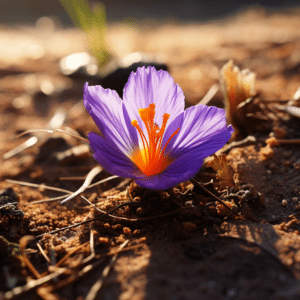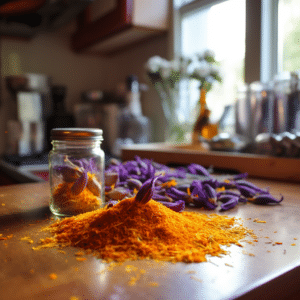Saffron, the vibrant crimson spice, known for its distinct flavor and mesmerizing aroma, has been prized for centuries. Its cultivation requires patience, skill, and attention to detail. In this ultimate guide, we will take you through the fascinating journey of growing saffron, providing you with valuable tips and techniques to ensure a successful harvest.
Understanding Saffron: A Brief Overview

Before diving into the cultivation process, it’s essential to understand the unique characteristics of saffron. Saffron comes from the flower Crocus sativus, commonly known as the saffron crocus. Each flower produces three stigmas, which are carefully handpicked and dried to create the highly sought-after spice.
The Unique Characteristics of Saffron
Saffron possesses qualities that set it apart from other plants. It requires specific growing conditions and demands attention throughout its lifecycle. The stigmas of saffron are known for their intense color, distinct floral aroma, and exquisite flavor, making it a valuable addition to various cuisines and traditional medicines.
One of the most intriguing aspects of saffron is its vibrant color. The stigmas of the saffron crocus flower are a deep crimson hue, which is released when they are harvested and dried. This vibrant color not only adds a visually appealing touch to dishes but also indicates the presence of the valuable compounds that give saffron its unique flavor and aroma.
Furthermore, the distinct floral aroma of saffron is a result of the volatile compounds present in the stigmas. These compounds are released when saffron is steeped in hot liquid, infusing the dish with a delightful fragrance that is instantly recognizable. The aroma of saffron is often described as warm, earthy, and slightly sweet, adding a layer of complexity to any recipe it is used in.
When it comes to flavor, saffron is truly unparalleled. The combination of its intense color and distinct aroma translates into a taste that is both delicate and powerful. Saffron adds a subtle bitterness and a hint of sweetness to dishes, elevating the overall flavor profile. Its unique taste is often described as floral, slightly honey-like, and with a touch of earthiness, making it a prized ingredient in both sweet and savory recipes.
Why Grow Your Own Saffron?
Growing your own saffron can be a rewarding experience. Not only will you have a fresh and sustainable supply of the spice, but you will also gain a deeper appreciation for the intricate process involved in its cultivation. Additionally, saffron farming can be a profitable endeavor, as the demand for this coveted spice continues to rise.
Imagine being able to step into your garden and pluck the vibrant saffron stigmas directly from the flowers. The satisfaction of knowing that you have nurtured these delicate plants and harvested the precious spice with your own hands is truly unmatched. By growing your own saffron, you have full control over the quality and purity of the spice, ensuring that you are using the finest saffron in your culinary creations.
Furthermore, saffron farming can be a lucrative business venture. With the increasing popularity of saffron in the culinary world and the growing demand for high-quality spices, cultivating saffron can provide a steady income stream. As a niche and highly sought-after product, saffron commands a premium price in the market, making it an attractive option for those looking to enter the agricultural industry.
Moreover, growing saffron can also have environmental benefits. Saffron crocus flowers are known for their ability to attract pollinators, such as bees and butterflies, which play a crucial role in maintaining biodiversity. By cultivating saffron, you are not only contributing to the preservation of these important pollinators but also creating a habitat that supports the overall health of your garden ecosystem.
In conclusion, understanding the unique characteristics of saffron and the benefits of growing your own can deepen your appreciation for this prized spice. From its vibrant color to its distinct aroma and exquisite flavor, saffron is truly a treasure in the culinary world. So why not embark on the journey of saffron cultivation and experience the joy of harvesting your own saffron, while also reaping the rewards of a sustainable and profitable endeavor?
Preparing for Saffron Cultivation

Successful saffron cultivation begins with proper preparation. Let’s explore the essential steps to ensure that your saffron plants thrive.
When it comes to cultivating saffron, there are several factors to consider. One of the most crucial aspects is choosing the right soil. The saffron crocus thrives in well-draining soil with a pH level between 6 and 8. It prefers sandy or loamy soil enriched with organic matter. Before planting the bulbs, it is essential to ensure that the soil is rich in nutrients and free from any debris or rocks that might hinder their growth.
Preparing the soil for saffron cultivation involves several steps. Firstly, it is advisable to test the soil’s pH level to determine its suitability for saffron crocuses. This can be done using a soil testing kit or by sending a sample to a laboratory for analysis. Once the pH level is determined, necessary amendments can be made to adjust it within the ideal range.
In addition to pH adjustment, it is crucial to prepare the soil by incorporating organic matter. This can be done by adding well-rotted compost or aged manure to improve the soil’s fertility and structure. Organic matter helps retain moisture and nutrients, promoting healthy growth and development of saffron plants.
Ideal Climate Conditions for Saffron
Saffron cultivation requires a cold, dry climate with mild winters and hot, dry summers. The plant thrives in regions with a Mediterranean climate or areas where the temperature remains between 68°F (20°C) and 86°F (30°C). The climate should also provide ample sunlight, as saffron crocuses require at least six hours of direct sunlight per day.
Understanding the climate requirements for saffron cultivation is essential for successful growth. In regions with cold winters, it is crucial to protect the saffron bulbs from frost by providing adequate insulation or planting them in containers that can be moved indoors during extreme weather conditions.
Furthermore, saffron crocuses require a period of dormancy during the winter months. This dormancy period allows the plants to conserve energy and prepare for the upcoming growing season. It is important to provide the saffron plants with the necessary conditions for dormancy, such as cooler temperatures and reduced watering.
While saffron can tolerate a wide range of temperatures, extreme heat can be detrimental to its growth. In regions with hot summers, it is advisable to provide shade or use mulch to protect the plants from excessive heat and prevent the soil from drying out too quickly.
When selecting a location for saffron cultivation, it is crucial to consider the microclimate of the area. Factors such as elevation, proximity to large bodies of water, and exposure to wind can significantly impact the suitability of the site for saffron cultivation. It is recommended to choose a location that offers protection from strong winds and excessive moisture, as these conditions can lead to bulb rot and other diseases.
Planting Your Saffron
Now that you have prepared the optimum growing conditions for saffron, it’s time to plant your bulbs and set the foundation for a successful harvest.
When to Plant Saffron
The best time to plant saffron bulbs is in late summer or early autumn, usually around September. This timing allows the bulbs to establish their roots before the colder temperatures arrive.
How to Plant Saffron Bulbs
Planting saffron bulbs is a straightforward process. First, create small holes around 3-4 inches (8-10 cm) deep in the soil. Gently place the bulbs, with their pointy ends facing upwards, into the holes. Cover them with loose soil, ensuring that they are adequately spaced, approximately 4 inches (10 cm) apart.
Caring for Your Saffron Plants
Proper care and maintenance are crucial to ensure healthy saffron plants and a bountiful harvest. Let’s explore the key aspects of saffron plant care.
Watering and Fertilizing Saffron
Saffron requires moderate watering throughout its lifecycle. Water the plants when the soil feels dry, but be cautious not to overwater, as this can lead to bulb rot. A well-balanced fertilizer, specifically formulated for flowering plants, can be applied in early spring and late autumn to provide the necessary nutrients for healthy growth.
Dealing with Pests and Diseases
Saffron plants are generally resilient to pests and diseases. However, common garden pests such as aphids and snails may occasionally pose a threat. Regularly inspect your plants for any signs of infestation and take appropriate measures, such as using organic insecticides or introducing natural predators, to maintain a pest-free environment.
Harvesting Your Saffron

The moment of truth has arrived. After patiently tending to your saffron plants, it’s time to reap the rewards of your hard work.
When and How to Harvest Saffron
Saffron blooms in the autumn, typically from October to November. The flowers only last for a short period, so a daily inspection is crucial. Once the flowers have fully opened, delicately pluck the vibrant red stigmas using tweezers or your fingertips. To preserve their quality, promptly dry the harvested stigmas in a cool, dark place.
Storing and Using Your Saffron
Proper storage is vital to maintain the flavor and potency of saffron. Keep the dried stigmas in an airtight container away from heat, light, and moisture. When using saffron in your culinary creations, remember that a little goes a long way. Add the threads to your dishes directly or steep them in warm liquid before incorporating them.
As you embark on your saffron-growing journey, keep in mind that patience and attention to detail are key. With this ultimate guide as your companion, you are well-equipped to cultivate your own saffron and savor the exquisite flavors and aromas that this precious spice offers. Happy gardening!